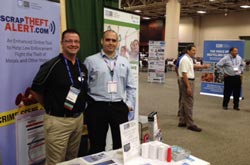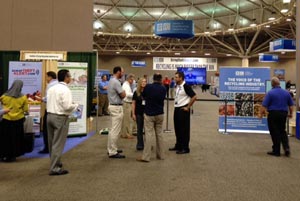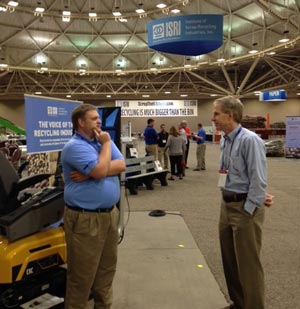ISRI Hits a Homerun at NCSL in Minneapolis!
 The 2014 National Conference of State Legislators (NCSL) Legislative Summit wrapped up last Thursday and there seems to be no doubt that everyone leaving this Minneapolis conference not only knows who ISRI is but has left with an eye-opening experience about the recycling industry. It appears that ISRI has further achieved its goal of raising the industry's profile among state legislators participating at NCSL and solidifying the idea that legislators should be consulting with ISRI members when it comes to matters of recycling. Here are some of the week’s highlights:
The 2014 National Conference of State Legislators (NCSL) Legislative Summit wrapped up last Thursday and there seems to be no doubt that everyone leaving this Minneapolis conference not only knows who ISRI is but has left with an eye-opening experience about the recycling industry. It appears that ISRI has further achieved its goal of raising the industry's profile among state legislators participating at NCSL and solidifying the idea that legislators should be consulting with ISRI members when it comes to matters of recycling. Here are some of the week’s highlights:
NCSL Business Meetings/Receptions
On Monday and Tuesday, ISRI attended the NCSL business meetings and VIP receptions for incoming NCSL President Senator Debbie Smith of Nevada and current NCSL President Senator Bruce Starr of Oregon. ISRI member Brian Henesey of Rocky Mountain Recycling reported having numerous valuable conversations with both business executives as well as legislators during the evening. ISRI also received a very vocal "shout out" of appreciation at the NCSL Foundation Board meeting for its platinum sponsorship and its sponsorship of the exhibit hall lunch this year by Senator Smith.
Late Night Party - Wednesday Evening
ISRI was a platinum sponsor of the State Government Affairs Council (SGAC)-hosted Late Night social event on Wednesday evening. This hugely popular annual event was once again a hit with NCSL attendees. The invitation-only event required a ticket for entry and only event sponsors had tickets to distribute.
As was case last year, ISRI members once again showed the power of ISRI grassroots. In the days leading up to the Summit and here at the Summit itself, ISRI members engaged with their legislators and invited them to the party. As a platinum sponsor, ISRI was allotted 100 tickets and our members collectively invited guests for every single ticket we had. This year ISRI members used the ISRI exhibit booth in the general exhibit hall as a “will call” distribution center for tickets, which brought legislators to the ISRI booth facilitating additional conversations about the industry.
The Late Night Party did not disappoint. The ISRI name was headlined on the marquee theater sign at the entrance as well as on signage and electronic billboards throughout the theater. The value in this sponsorship showed itself in two different ways. Not only did ISRI get its name out there as an organization that carries weight and is a major player, but it also served as a vehicle to get ISRI members engaged with their legislators. They really worked diligently to contact and communicate with state legislators, as evidenced by the numbers of tickets they distributed.
Exhibit Hall - All Week
 The NCSL Exhibit Hall hosted more than 1,000 interest groups/companies pitching their messages, and ISRI participated with a booth of its own that was staffed at all times with at least one ISRI member alongside ISRI staff. The booth was a central point of information about the industry and allowed ISRI members to engage in some productive conversations with legislators from all over the country. It had a computer set up with access to the ISRI jobs study, ScrapTheftAlert.com, the new metals theft law database, and the JASON Project materials as well as various industry information pieces.
The NCSL Exhibit Hall hosted more than 1,000 interest groups/companies pitching their messages, and ISRI participated with a booth of its own that was staffed at all times with at least one ISRI member alongside ISRI staff. The booth was a central point of information about the industry and allowed ISRI members to engage in some productive conversations with legislators from all over the country. It had a computer set up with access to the ISRI jobs study, ScrapTheftAlert.com, the new metals theft law database, and the JASON Project materials as well as various industry information pieces.
The ISRI booth featured a "count the can" contest sponsored in part by New Ulm Recycling. The contest included a brick of crushed aluminum cans and a prize provided by ISRI for the person who guessed closest to the number of cans in the brick. We had legislators coming to the booth right up to the closing minutes putting in their guesses. Of course, it was also used as an opportunity to talk to the legislator and give him or her some information about ISRI. In the end, no one had the exact number but a Colorado legislator was selected as the “closest without going over” with a guess of 1,501 cans (the brick had 1,561 cans).
The ISRI booth also served as the entrance and exit to the Exhibit Hall lunch allowing ISRI members to effectively engage with any legislator coming or going from the lunch. ISRI members at the booth engaged with legislators and were able to point right into the lunch hall and offer to give them a personal tour of the displays in it. Furthermore, in the lunch hall, there was an enormous “Bigger than the Bin” ISRI banner that was readable from the other end of the adjoining exhibit hall both Wednesday and Thursday.
Exhibit Hall Lunch
 From all appearances, it appeared that ISRI’s sponsorship of the lunch was a success. The goal of the lunch sponsorship was to have legislators leave NCSL with no doubt that recycling is much bigger than the bin and ISRI is the organization that represents the recycling industry. If the enormous banner in the hall didn't catch their attention, then the crushed cars, baled non-ferrous materials, huge material handler, Genesis shear, park bench from recycled rubber, Volvo simulator, and other displays did. Members of the ISRI Northwest Chapter came through big for ISRI. Without their participation, there is no way the lunch would have been the success that it was this year. The visible displays brought the world of recycling to the legislators in a way they had never seen before and certainly in a fashion that could never be conveyed in literature alone.
From all appearances, it appeared that ISRI’s sponsorship of the lunch was a success. The goal of the lunch sponsorship was to have legislators leave NCSL with no doubt that recycling is much bigger than the bin and ISRI is the organization that represents the recycling industry. If the enormous banner in the hall didn't catch their attention, then the crushed cars, baled non-ferrous materials, huge material handler, Genesis shear, park bench from recycled rubber, Volvo simulator, and other displays did. Members of the ISRI Northwest Chapter came through big for ISRI. Without their participation, there is no way the lunch would have been the success that it was this year. The visible displays brought the world of recycling to the legislators in a way they had never seen before and certainly in a fashion that could never be conveyed in literature alone.
Equipment Displays New to the lunch exhibit this year was equipment supplied by Road Machinery facilitated by a request from Eva Shine of the Northwest Chapter. In the hall was a large Sennebogan material handler and a Genesis shear which attracted a great deal of attention and “Wow” factor. The equipment was staffed by representatives from those companies, who also provided videos of the equipment in action to really bring the process to life. Several comments from attendees suggested how this large-scale demonstration really helped them envision how much material our industry handles in comparison to the visual of the curbside bin they always associated with recycling. In addition to this equipment, Volvo brought in its excavator simulator for attendees to get a feel for operating such equipment. The simulator idea generated great excitement.
Ferrous Display
Thanks to Alter Recycling, ferrous was represented by a 43 foot trailer loaded with two crushed cars and a gaylord box full of shred. A video from Lindner showing the shredding process brought the display to life. It was a very professional display of the process a scrap vehicle travels through on its way to becoming new raw materials. Chris Phelps and Bret Robinson of Alter Trading and others were on-site by the trailer to discuss the recycling process with the uncountable numbers of “gawkers” who seemed to take pause at the idea of two stacked crushed cars being transformed into fist-size pieces of metal as visualized on the back of that Alter trailer.
Nonferrous Display
Thanks again to Alter Recycling, nonferrous had a life-size display that brought the enormous scale of the industry into vision. The display consisted of three large bales of copper piping, insulated copper wire, and aluminum. It also featured a count the can contest with a brick of crushed aluminum cans that had an award for the entry closest to the exact number. The ISRI fact sheet for nonferrous helped tie all the materials together and their importance to the economy and environment. The ISRI banners on ScrapTheftAlert.com and StopMetalsTheft.org were placed near this display to serve as a talking piece on the subject.
Paper Display
Pioneer Industries provided a bale of newspaper and some samples of new products developed from #9 News along with shredded paper for the centerpiece jars.
Electronics Display
Electronics recyclers were represented thanks to IRT in Minneapolis. The electronics were popular among attendees given the touch and feel display both at the exhibit as well as in the centerpieces on the lunch tables. The exhibit displayed computer and various electronic equipment as it is broken down and recycled, with large glass jars of the scrap that results from the recycling process.
Tire/Rubber Display
Tire and Rubber went big providing not only examples of recycled tire product such as crumb rubber for legislators to touch and feel, but the commodity was a popular attraction because of a generous donation by Champlain Recycling. This year’s display included a full scale park bench made of recycled tires and plastic engraved with “Recycling is Bigger than the Bin” on the bench, which was donated not only as a display but as the winning prize for a Guess the Number of Tires contest. With the assistance of Mike Hinsley, Troy Hess, and others, a bale of tire wire was displayed and attendees were encouraged to guess the number of tires this wire came from in order to win the bench. It attracted not only the weary wanting to take a rest on the bench, but apparently some engineers who were determined to calculate the number of tires by density, weight, and even tire brand. This exhibit proved to be very popular as it had examples of various tire/rubber products that attendees could touch as they watched videos of the process on a large TV screen.
Plastics Display
With the help of ISRI member Hilex Poly, plastics had an impressive display including a full bale of used plastic bags alongside new plastic product manufactured from those bags. This served as a very timely reminder for legislators that plastic bags are not trash, at a time when states are increasingly being asked to look into banning the plastic bag altogether.
Lunch Table Centerpieces
As briefly mentioned above, there were centerpieces placed on all 200 tables for purposes of starting conversation about recycling. ISRI provided 32 oz. clear plastic jars to Northern Metal Recycling, an EMR facility in Minneapolis, at which the NW Chapter President Tony White took the time to fill with shred from each commodity that was shipped to him for this purpose. The jars were labeled with the ISRI logo and a phrase "I used to be a _____" with the blank filled in with a description of where the material could have originated. For example, the ferrous jars had labels that said things like "I used to be a Chevy,” and the electronics jars had shred in it with labels such as "I used to be a laptop" or "I used to be an Apple computer." These centerpieces were the talk of the day.
The lunch tables also featured recycling ”trivial pursuit” cards that proved to be a hit with attendees. One Minnesota legislator who is also an educator informed ISRI member Eva Shine that he wanted to use the cards in his classroom. The cards clearly served as an effective eye-opening piece of "fun" literature that helped facilitate positive conversation about the industry. In addition to the trivia cards, the tables also featured the job study postcard, JASON Project brochure and a sheet outlining the top state policy issues for recyclers.
Lunch Volunteers
Thanks to the efforts of Eva Shine and the ISRI NW Chapter, there were around 40 volunteers at the lunch to mix and mingle with attendees and talk about our industry. The volunteers stood ready to answer questions at the entrance of the hall by the displays that lined the walkway to the food and helped spark interest in the exhibit displays we had in the hall. Without the efforts of Eva and the NW Chapter members, the lunch would not have been nearly as successful as it was for ISRI.
Door Greeters
As was the case last year, several ISRI members indicated that one of the most productive parts of the lunch and ISRI booth placement was how they were able to stand and greet legislators as they came in and left the lunch hall. Brian Henesey, Randy Goodman, Mike Potash and others, stationed themselves at the door and were able to thank legislators for coming and hand out the ScrapTheftAlert.com flashlights as a departing gift. The setup allowed for the ISRI members to get instant feedback from legislators on the lunch and their impressions about ISRI. It has been reported that the feedback was extremely positive.
Next year’s summit will be in Seattle, and we look forward to having another great event there and outreach to the thousands of state legislators that will be in attendance.
Danielle Waterfield is Assistant Counsel and Director of Government Relations at ISRI.